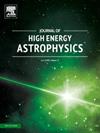Spectro-temporal investigation of quasi-periodic oscillations from black hole X-ray binary 4U 1630-472 using NICER
IF 10.2
4区 物理与天体物理
Q1 ASTRONOMY & ASTROPHYSICS
引用次数: 0
Abstract
We present a comprehensive analysis of the spectro-temporal characteristics of the X-ray variabilities from black hole X-ray binary 4U 1630–472 during its three outbursts (2018, 2020, and 2021) as observed by NICER. We detected 27 Quasi-Periodic Oscillations (QPOs), out of which 25 were observed during the 2021 outburst. In this study, we specifically focus on the relationship between spectral and timing parameters and the frequency of type-C QPOs in the 2021 outburst of the black hole binary 4U 1630–472 during its rising phase. We found strong correlations between the photon index of the non-thermal emission and the QPO frequency. We also observed a critical frequency at ∼ 2.31 Hz, above which the behavior of the Q-factor of the QPO changed significantly with the QPO frequency. We further identified two events characterized by a surge in the total flux, corresponding to the disappearance of type-C QPOs. Although the first event appeared like an X-ray flare, during the second event, the source reached a state with a total flux higher than 10−8 erg/cm2/s and exhibited a different type of QPO with lower frequencies and weaker amplitudes. We compare our results with the previously reported QPO characteristics for black hole outbursts and discuss the various models that could interpret the critical frequency and potentially explain the origin and evolution of these type-C QPOs.
求助全文
约1分钟内获得全文
求助全文
来源期刊

Journal of High Energy Astrophysics
Earth and Planetary Sciences-Space and Planetary Science
CiteScore
9.70
自引率
5.30%
发文量
38
审稿时长
65 days
期刊介绍:
The journal welcomes manuscripts on theoretical models, simulations, and observations of highly energetic astrophysical objects both in our Galaxy and beyond. Among those, black holes at all scales, neutron stars, pulsars and their nebula, binaries, novae and supernovae, their remnants, active galaxies, and clusters are just a few examples. The journal will consider research across the whole electromagnetic spectrum, as well as research using various messengers, such as gravitational waves or neutrinos. Effects of high-energy phenomena on cosmology and star-formation, results from dedicated surveys expanding the knowledge of extreme environments, and astrophysical implications of dark matter are also welcomed topics.
 求助内容:
求助内容: 应助结果提醒方式:
应助结果提醒方式:


